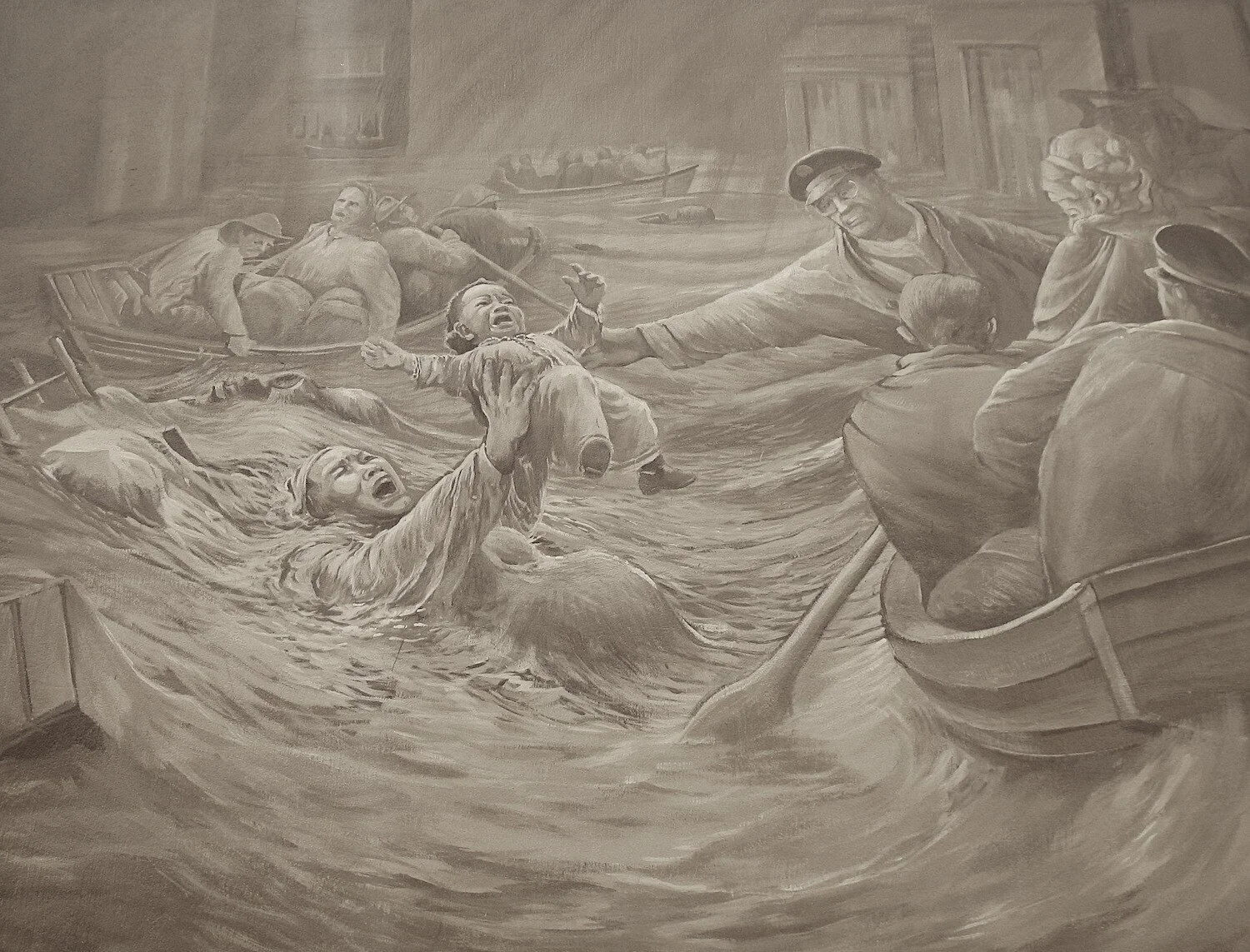Wall of Water
Portsmouth, Ohio
i.
January’s rain refused to relent.
Twenty two days straight
the Ohio River gorged itself
on winter storm, its swollen belly
bloated within reach of breaching
the 1907 floodwall. Portsmouth
held its breath to no avail.
She fell before the swarming horde
of the whole watershed’s invading host.
A seventy-four foot roll of river
surged through sewers, tossed manholes
like a juggler with plates, cascading
over sandbags stacked atop
the impotent wall under a wall of water.
ii.
The cold and hungry refugees
at Washington School hailed the late
arrival of rescuers. Pregnant Bessie
Tomlin and her three children
bumbled into Walter Chick’s
wobbly boat, and off toward Waller
they rowed, when a rogue wave capsized
them into the freezing flotsam wash.
Bessie emerged frantically shouting,
“Save my baby! Save my baby!”
Chick grabbed little Alberta just as
Bessie was pulled back under the surface,
succumbing to the numbing cold,
holding her breath under the wall of water.
iii.
A river is a fickle lover,
promising some young city her future,
then all too soon in psychotic rage,
void of pity, swamps her to ruin,
battering with a two-faced bludgeon:
stripping away, then smothering.
The cruel cold shoulder plunders
priceless treasure and last night’s trash
without a hint of discrimination.
And after the unceremonious shove
it covers everything in mud,
suffocation under a foot of silt–
a lover undoing the city he built
wall by wall under a wall of water.
iv.
Chastened by underestimation,
The Citizens Flood Defense Committee
(if there is such a thing) began
The “It Can’t Happen Again” campaign
(if such a thing can be) and called
The Army Corps of Engineers
to erect yet another wall.
The rebuilt city trusts again,
the battered lover returning home
before the bruises have faded away,
remembering 1884,
remembering 1913. So,
rivers will be rivers, won’t they?
Loose blouse flapping in the breeze,
flinching at the passing freight train
whose rumble sounds like distant thunder.
Clouds look menacing in the east,
gathering like a pent up wall of water.
v.
With the spent sky shut down,
the river slunk back to its banks.
A full week after Bessie’s drowning
someone found her rag doll body
at the corner of 10th and Waller,
only a block away from where
she had tumbled from her rescue boat.
Something familiar about her fall.
Recently she had jumped ship
from her tumultuous mess of a marriage.
Word was out that William abused her
and she had finally had enough.
Brief her free air out from under
his control, only to stumble into
more of the same, another hell
with a different name, a choking wall of water.
vi.
Like a kitchen maid turned princess,
the wall is clothed in magnificent murals.
Art, the archaeologist of story,
removes the sediment layers of progress
with every tender layer of paint
portraying Portsmouth history.
Robert Dafford brushes back time
undoing the crime that undid the city,
returning exiles and exhuming bones,
Isaiah’s promise! Ezekiel’s vision!
The Boneyfiddle parade begins in
the east at the site of the ancient mounds
and ends on Grant bridge (no longer around).
Portsmouth no longer is holding its breath!
Finally a floodwall to hold the river—
not by the strength of its concrete mass—
by becoming its equal and opposite force,
canceling the miscreant by making it carry
the bier of her whose glory was greater.
The baby daughter in Bessie’s arms,
lifted up into the storm
is riding high atop, above, beyond the wall of water.
NOTES
1.Rain began falling over the Ohio River watershed on January 5, 1937 and continued for 22 consecutive days. On January 27, the Ohio River crested at 74.23 feet, exceeding the flood stage by more than 12 feet. As a result, the city of Portsmouth was dramatically flooded and more than 35,000 residents were left homeless.
2. The 1907 floodwall was built to protect up to a 62 foot flood stage.
3. Bessie Tomlin was Portsmouth’s single fatality in the 1937 flood. People found shelter in schools across the city awaiting rescue. The refugees at Booker T. Washington School, including Bessie and her family, had been without any food or fuel for a day and a half. Rescue boats finally arrived Monday, January 25. While Bessie, her three children, and her mother-in-law among others, rowed away from the school, their boat capsized. Everyone was quickly retrieved, but rescuers lost sight of Bessie. She emerged moments later lifting her 18 month daughter Alberta above the swirling waters. Fireman Walter Chick was able to grab the baby, but Bessie went under again and disappeared. She was pregnant at the time of her tragic drowning and had recently left her abusive husband. https://sciotohistorical.org/items/show/45
4. Construction began in June 1940 to construct a floodwall and levy system that would withstand a 77.1 foot flood stage. This new wall was 20 feet high and 2000 feet long .
5. Among the many flooding events that have happened throughout Portsmouth’s history, the floods of 1884 and 1913 stand out as particularly severe.
6. In 1993 the Portsmouth Floodwall Murals Project began. Using Carl Ackerman’s collection of Portsmouth history photographs, muralist Robert Dafford and his team of talented painters proceed to paint 52 murals of Portsmouth’s history in chronological order stretching east to west.
7. See Isaiah 43:5-7; Ezekiel 37
8. Boneyfiddle is the name for Portsmouth’s downtown business district.
9. Site of the ancient mounds refers to the first panel of the floodwall, a depiction of mounds in southern Ohio long before western explorers came to the new world occupied by Adena, Hopewell, and Fort Ancient cultures.
10. Grant Bridge no longer around refers to the Ulysses S. Grant Bridge, demolished in 2001, which is featured on the final panel of the main floodwall.
